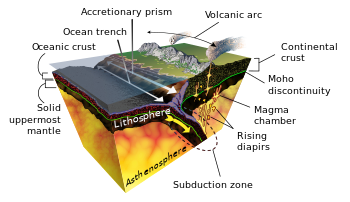Accretion (geology)


Ingeology,accretionis a process by which material is added to atectonic plateat asubduction zone,frequently on the edge of existing continentallandmasses.The added material may be sediment,volcanic arcs,seamounts,oceanic crustor other igneous features.[1][2][3]
Description
[edit]Accretion involves the addition of material to atectonic plateviasubduction,the process by which one plate is forced under the other when two plates collide.[3]The plate which is being forced down, the subducted plate, is pushed against the upper, over-riding plate. Sediment on the ocean floor of the subducting plate is often scraped off as the plate descends. This accumulated material is called anaccretionary wedge(or accretionary prism), which is pushed against and attaches to the upper plate.[3]In addition to accumulated ocean sediments, volcanic island arcs or seamounts present on the subducting plate may be amalgamated onto existingcontinental cruston the upper plate, increasing the continental landmass.[3]
Continent building
[edit]Continental crust differs significantly from oceanic crust. Oceanic crust is primarily composed ofbasalticrocks, which have a higherdensitythan the rocks making up the majority of continental crust.[4]Island arcs and other volcanic rocks are also lower in density than the oceanic crust, and are therefore not easily subducted along with the oceanic crust that surrounds them. Instead, these less-dense bits of crust will collide with existing continental crust on the upper plate once the oceanic crust separating them is completely subducted.[3]Most continents are composed of multiple accreted "terranes",pieces of low-density continental crust with different origins. For example,North Americais made up of multiple accreted terranes that collided with theLaurentian proto-continent,such as theProterozoicYavapai,Mazatzal,andGrenville ProvinceTerranes.[5]Accreted terranes along modern subduction plate boundaries include theNankai accretionary complexof Japan (subduction of thePhilippine Platebeneath theEurasian Plate), theBarbados Ridgein the Caribbean (subduction of theCaribbean Platebeneath theNorth American Plate), and theMediterranean Ridge(subduction of theAfrican Platebeneath the Eurasian Plate). These examples of accreted terranes also all include accretionary wedges.[6][7][8]
References
[edit]- ^Ballard, Robert D. (1988).Exploring our living planet.National Geographic Book Service., National Geographic Society (U.S.) (Rev. ed.). Washington, D.C.: National Geographic Society.ISBN0-87044-760-2.OCLC18325626.
- ^Sattler, Helen Roney (1995).Our patchwork planet: the story of plate tectonics.Maestro, Giulio (1st ed.). New York: Lothrop, Lee & Shepard Books.ISBN0-688-09312-4.OCLC21372888.
- ^abcdeVan der Pluijm, Ben A.; Marshak, Stephen (2004).Earth structure: an introduction to structural geology and tectonics(2nd ed.). New York: W.W. Norton.ISBN0-393-92467-X.OCLC53231817.
- ^Davies, Geoffrey F. (Geoffrey Frederick) (2011).Mantle convection for geologists.Cambridge: Cambridge University Press.ISBN978-0-511-99304-6.OCLC705368249.
- ^Whitmeyer, Steven J.; Karlstrom, Karl E. (2007)."Tectonic model for the Proterozoic growth of North America".Geosphere.3(4): 220–259.doi:10.1130/GES00055.1.
- ^Moore, G. F.; Shipley, T. H.; Stoffa, P. L.; Karig, D. E.; Taira, A.; Kuramoto, S.; Tokuyama, H.; Suyehiro, K. (1990). "Structure of the Nankai Trough Accretionary Zone from multichannel seismic reflection data".Journal of Geophysical Research: Solid Earth.95(B6): 8753–8765.Bibcode:1990JGR....95.8753M.doi:10.1029/JB095iB06p08753.ISSN2156-2202.
- ^Deville, Eric; Mascle, Alain (2012-01-01), Roberts, D. G.; Bally, A. W. (eds.),"21 - The Barbados ridge: A mature accretionary wedge in front of the Lesser Antilles active margin",Regional Geology and Tectonics: Principles of Geologic Analysis,Elsevier, pp. 580–607,doi:10.1016/b978-0-444-53042-4.00021-2,ISBN978-0-444-53042-4,retrieved2020-03-09
- ^Chaumillon, Eric; Mascle, Jean (1997). "From foreland to forearc domains: New multichannel seismic reflection survey of the Mediterranean ridge accretionary complex (Eastern Mediterranean)".Marine Geology.138(3–4): 237–259.Bibcode:1997MGeol.138..237C.doi:10.1016/s0025-3227(97)00002-9.ISSN0025-3227.
